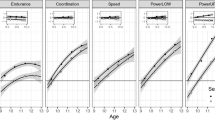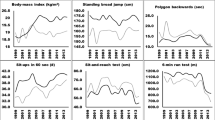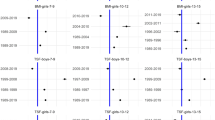Abstract
We compared values of body mass index (BMI) and cardiorespiratory fitness (20 m shuttle-run test) of n=157 boys and n=150 girls aged 10–11 measured in 2014 with measures from 2008 and 1998. Boys’ fitness was lower (d=0.68) in 2014 than 2008, despite a small (d=0.37) decline in BMI. Girl’s BMI changed trivially (d=0.08) but cardiorespiratory fitness was lower (d=0.47) in 2014 than 2008. This study suggests fitness is declining at 0.95% per year, which exceeds the 0.8% rate of decline we reported between 1998 and 2008 and is double the global average of 0.43%. Declines in fitness were independent of changes in BMI suggesting continued reductions in English children’s habitual physical activity levels.
This is a preview of subscription content, access via your institution
Access options
Subscribe to this journal
Receive 12 print issues and online access
$259.00 per year
only $21.58 per issue
Buy this article
- Purchase on Springer Link
- Instant access to full article PDF
Prices may be subject to local taxes which are calculated during checkout

Similar content being viewed by others
References
Ruiz JR, Ortega FB, Rizzo NS, Villa I, Hurtig-Wennlof A, Oja L et al. High cardiovascular fitness is associated with low metabolic risk score in children: the European Youth Heart Study. Pediatr Res 2007; 61: 350–355.
Ortega FB, Ruiz JR, Castillo MJ, Sjostrom M . Physical fitness in childhood and adolescence: a powerful marker of health. Int J Obesity 2008; 32: 1–11.
Tomkinson GR, Leger LA, Olds TS, Cazorla G . Secular trends in the performance of children and adolescents (1980-2000): an analysis of 55 studies of the 20 m shuttle run test in 11 countries. Sports Med 2003; 33: 285–300.
Stratton G, Canoy D, Boddy LM, Taylor SR, Hackett AF, Buchan IE . Cardiorespiratory fitness and body mass index of 9-11-year-old English children: a serial cross-sectional study from 1998 to 2004. Int J Obes 2007; 31: 1172–1178.
Olds TS, Ridley K, Tomkinson GR . Declines in aerobic fitness: are they only due to increasing fatness? Med Sport Sci 2007; 50: 226–240.
Sandercock G, Voss C, McConnell D, Rayner P . Ten year secular declines in the cardiorespiratory fitness of affluent English children are largely independent of changes in body mass index. Arch Dis Child 2010; 95: 46–47.
Conrad D, Capewell S . Associations between deprivation and rates of childhood overweight and obesity in England, 2007-2010: an ecological study. BMJ Open 2012; 2: e000463.
Chief Medical Officer The 2009 Annual Report of the Cheif Medical Officer. Department of Heatlh: London, UK. Available at http://www.dh.gov.uk/prod_consum_dh/groups/dh_digitalassets/@dh/@en/@ps/documents/digitalasset/dh_114012.pdf 2009 (Last accessed 20 May 2015).
Government DfCaL The English Indices of Deprivation 2007. Department for Communities and Local Government: London, UK, 2007.
Cohen D, Voss C, Sandercock GRH . 'Fitness Testing' for children: let's mount the Zebra!. J Phys Act Health; e-pub ahead of print 5 June 2014.
Cole TJ, Freeman JV, Preece MA . Body mass index reference curves for the UK, 1990. Arch Dis Child 1995; 73: 25–29.
Batterham AM, Atkinson G . How big does my sample need to be? A primer on the murky world of sample size estimation. Phys Ther Sport 2005; 6: 153–163.
Georgiades E, Reilly JJ, Stathopoulou E, Livingston AM, Pitsiladis YP . BMI distribution changes in adolescent British girls. Arch Dis Child 2003; 88: 978–979.
Barker A, Williams C, Tolfrey K, Fawkner S, Sandercock G . The BASES Expert Statement on Measurement and Interpretation of Aerobic Fitness in Young People. British Association of Sport and Exercise Sciences: Leeds, UK, 2013.
Griffith R, Lluberas R, Lührmann M . IFS Briefing Notes (BN142) Gluttony in England? Long-term change in diet. Institute for Fiscal Studies: London, UK, 2013.
Author information
Authors and Affiliations
Corresponding author
Ethics declarations
Competing interests
The authors declare no conflict of interest.
Rights and permissions
About this article
Cite this article
Sandercock, G., Ogunleye, A. & Voss, C. Six-year changes in body mass index and cardiorespiratory fitness of English schoolchildren from an affluent area. Int J Obes 39, 1504–1507 (2015). https://doi.org/10.1038/ijo.2015.105
Received:
Revised:
Accepted:
Published:
Issue Date:
DOI: https://doi.org/10.1038/ijo.2015.105
This article is cited by
-
Associations Between Motor Competence and Physical Activity, Physical Fitness and Psychosocial Characteristics in Adolescents: A Systematic Review and Meta-analysis
Sports Medicine (2023)
-
An Update on Secular Trends in Physical Fitness of Children and Adolescents from 1972 to 2015: A Systematic Review
Sports Medicine (2021)
-
Performance and reproducibility on shuttle run test between obese and non-obese children: a cross-sectional study
BMC Pediatrics (2017)



